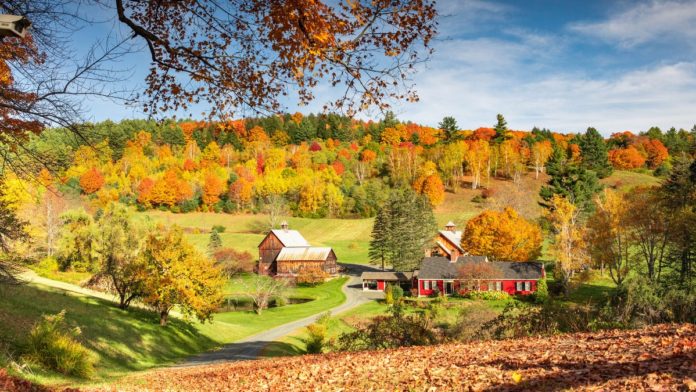Few seasons are as packed with as much travel potential as fall. Leaves light up forests, summer crowds are gone, and the heat gives way to crisp air, making it perhaps the best time of year to get outside and explore. Americans are understandably ready. Road trips have never been more popular, and people are beginning to look further afield, too. Traveling abroad to some places is easier than you might think—provided you do your homework. Many countries, like Iceland, simply require proof of vaccination or a negative COVID-19 test prior to landing. Still, traveling now calls for flexibility and smart planning, especially as the Delta strain of COVID-19 creates uncertainty. Always double check the news about restrictions in a place before arriving, and if we’ve learned anything from the pandemic, it’s how to adapt on the fly and embrace change. That’s how many of the best adventures come together anyway. To celebrate fall, we compiled a list of destinations that avoid crowds and get you outside, whether you decide to travel now or in the future. See you on the road. —Ryan Krogh
Explore Colorado’s Grand Mesa
Colorado’s shimmering golden aspens make the state’s trails prettier—and more popular—than ever in fall. But there’s a way to have them to yourself. Head to the newly renovated Electric Mountain Lodge (from $350), about 80 miles east of Grand Junction. Located at 9,200 feet atop the Grand Mesa—the world’s largest flat-top mountain—the four-room, five-cabin property sits at the gateway to Grand Mesa National Forest, providing guests access to over 300,000 acres of backcountry. The remote location feels like your own private park, with 200-some miles of trails for mountain biking and hiking, plus lakes for paddling and casting—all of them directly outside your front door. Fly fishing on the Roaring Fork River and mountain biking the Palisade Plunge, 32 miles of thrilling downhill singletrack, are easy day trips. Meals, served at Electric Mountain’s main timber-framed lodge, are mostly sourced from the chef’s farm in nearby Paonia—think kale and feta salad, roasted beet bruschetta, and grass-fed burgers—and are a reminder why this area is known as the state’s breadbasket. This region is also the heart of Colorado’s burgeoning wine scene. Book tastings at Azura Cellars and the Storm Cellars to see why the wines are starting to turn heads. —Jennifer Murphy
Chill Out on Molokai, Hawaii

Fall is typically Hawaii’s shoulder season, when daytime temperatures cool to a blissful 70-degrees, hotel prices drop, and crowds thin. However, travel has flooded back after pandemic lockdowns, and islands like Maui and Oahu are once again packed with travelers. But there is still Molokai, the antithesis of resort-lined Waikiki. With no stoplight and just a single hotel, the island beckons travelers who crave a slower pace and empty beaches. Hotel Molokai (from $140), with its retro, Polynesian-style bungalows, is a central base close to the main town of Kaunakakai, as well as the sacred Kapuaiwa Coconut Grove that was planted in the 1860s by King Kamehameha V. For a more far flung escape, head to the west side of the island and book one of the campsites (from $5) at Papohaku Beach. The largest white-sand beach on the island stretches for three miles and is 100 yards wide, so it feels like your own private island. Halawa Valley, home to one of the earliest Hawaiian villages, is a 90-minute drive to the island’s east end, and the winding road is worth the trip. The last born-and-raised descendant of the valley, Anakala Pilipo Solatori, still lives there, and he’ll take you on a three-mile hike to Moal’ula Falls through his guiding outfit Halawai Valley Falls Cultural Hike. Solatori’s conversation and the falls are far way more memorable than any luau. —J.M.
Adventure in Texas Hill Country
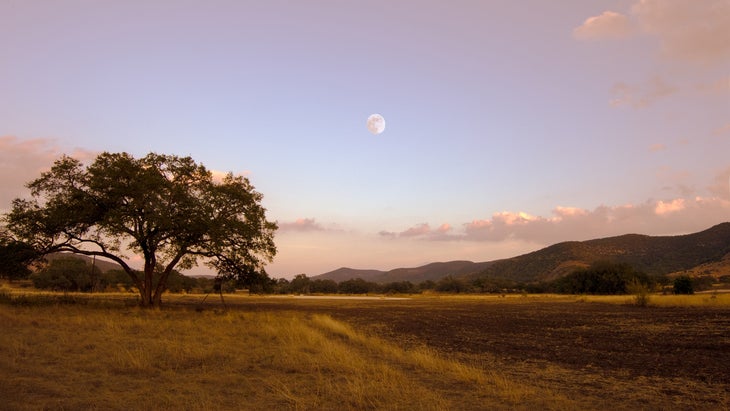
Hill Country mostly gets pegged as a great day trip from Austin or San Antonio, thanks to its surplus of antique stores and 100-plus vineyards. Increasingly, though, the area’s rolling limestone and granite hills and spring-fed rivers are luring mountain bikers, climbers, hikers, and paddlers. There’s no better time to visit than the fall, when the summer sun stops pounding Central Texas with 100-degree heat. Milton Reimers Ranch Park, 30 miles northwest of downtown Austin, offers 18 miles of flow trails for mountain biking and a wide selection of sport climbs, ranging from 5.5 to 5.14, on limestone cliffs that overlook the Pedernales River, perfect for a post-adrenaline-rush, cool-down dunk. Further southwest, between the towns of Boerne and Fredericksburg, is Flat Rock Ranch, a family-owned cattle operation that carved 29 miles of mountain biking trails into its 1,300 acres, with hill climbs, long downhill sections, technical singletrack, and several creek crossings. Just 10-minutes away are the clear waters of the Guadalupe River, which paddlers flock to for trips along its cypress tree–lined banks. For hiking, there’s Enchanted Rock State Natural Area, home to the U.S.’s second largest granite dome, rising 425 feet above the surrounding landscape. The state park has 11 miles of trails, and if you’re headed there it’s almost mandatory to march to the top of the Summit Trail for 360-degree views of Hill Country. For a longer hike, there’s the 4.6-mile Loop Trail, which circumnavigates the dome. Either way, make sure to leave early in the morning to avoid the sunbaked afternoons, which can still get uncomfortable in September. Celebrate the summit with lunch at Vaudeville, in nearby Fredericksburg, with pork belly tacos that are some of the best in the state—and in Texas, that’s saying something. They have a full selection of Texas wines by the glass—and bottles to go, too—in case you’re in the mood. For a place to bed down, there’s TrueHeart, with twelve cottages and a lush garden tucked away just off Main Street (from $215). —R.K.
Bike Tour Vermont’s Culinary Heartland
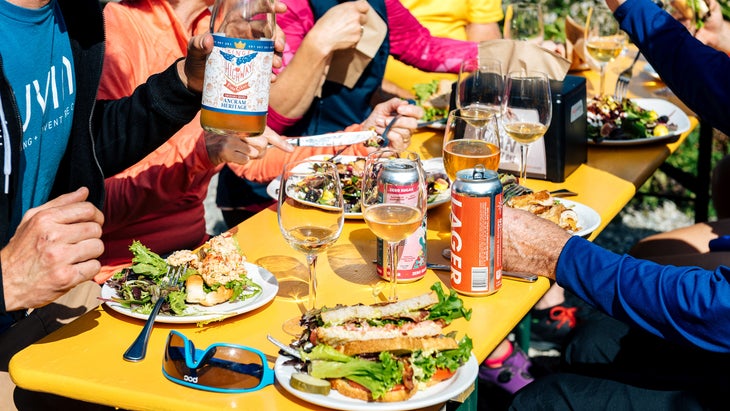
Vermont is no secret in the fall, when its vast tree canopies—more than 80 percent of the state is forested—transform into an eye-popping patchwork of marigold, ochre, and burgundy hues. Combine that with the area’s farmhouse-dotted countryside, artisanal cheeses and microbrews, and general bucolic vibe, and it makes sense why road-tripping through the state is high on anyone’s autumn bucket list. But there is a better way to see the leaves: by bike, so you’re not forced to experience the scenery in blurs of color, and you can work off all those fresh apple cider doughnuts. There’s a new outfitted bike tour that’s dedicated to the state’s artisanal food from DuVine Cycling ($3,895). The weekend tour covers nine to 52 miles a day, with options for serious climbs tackling 4,969 feet of elevation gain, and plenty of stops to sample Vermont staples like cider from Fable Farm, nutty Tarentaise cheese from Thistle Hill Farm, and seasonal Harvest brown ale from Long Trail Brewing Co. At night, a cozy, six-person cabin in the charming village of Woodstock is your private base. Not a biker? The options to slow down and enjoy the colors are endless, from leaf-peeping while hiking a section of the Appalachian Trail between Pomfret and West Hartford to kayaking on the 750-acre Chittenden Reservoir with local outfit Appalachian Trail Adventures. Surrounded by Green Mountain National Forest, paddle excursions double as safaris, with moose, fox, beaver, and bald eagle sightings common in fall. —J.M.
Go Beyond the Beach in Bermuda

With a storied pirate history, centuries of sailing lore, and the infamous “triangle” sewn thick into Bermuda’s fabric, the Atlantic archipelago just 90 minutes by plane from New York is full of intrigue. It’s also full of legit adventures. Intrepid locals have long practiced what is now known as deep-water free-soloing—climbing sheer limestone faces with only the ocean to break your fall—and free diving among hundreds of shipwrecks that rest offshore. Recent attractions have made the island a beacon for outdoor-lovers looking for more than a beach vacation, including the Bermuda Rail Trail National Park, 18 mostly-paved miles covering the island from tip-to-tail. It’s prime mountain biking and trail-running terrain, with quiet beaches for a lonely swim all along the way. In fall, island temperatures hover in the low-80s, and the ocean temps peak in late August, so the water is still warm. There’s always the risk of a hurricane at this time, but most storm activity is only glancing blows, with plenty of warning to decide whether to stay or go. Plus, room rates are usually significantly discounted after August. This summer saw the opening of the St. Regis Bermuda Resort (from $583) on Gates Bay in St. George’s, where the Sea Venture wrecked in 1609, spawning Bermuda’s accidental founding. Also new this year, thanks to the pandemic, is the “Work from Bermuda Certificate”, which was designed as a way for non-Bermudians to work remotely from the island for up to a year. The government’s site includes extended-stay options, vacation-home rentals, and a concierge service to make sure digital nomads have everything they need. —Terry Ward
Discover Oregon’s Other Best Adventure Town
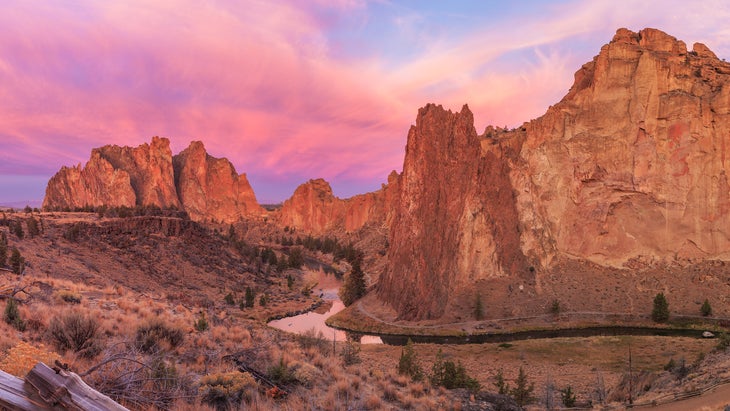
The small town of Sisters often gets relegated to the backseat when it’s compared to adventure-mecca Bend, but the artsy community shouldn’t be overlooked as a nature-lover’s paradise, especially in fall. While the vibe is more homegrown than hip, you can’t beat its access to the outdoors and friendly vibes. The 36 craftsman-style cabins at FivePine Lodge & Spa (from $241) are nestled in a ponderosa forest and biking distance to the Peterson Ridge Trail system, a mix of single track and forest service roads. From town, you can cycle 32 miles to the towering spires of Smith Rock State Park, an underrated gem laced with trails for hiking and bolted routes for climbing. And the bucket-list McKenzie River Trail, a 25-mile singletrack with stunning views, is just an hour’s drive away. While most of Central Oregon is swathed in ponderosa pine and juniper, the greater Sisters area also boasts an abundance of aspens and western larch trees that are ablaze in color each fall. This being Oregon, you’ll have your pick of epic food trucks—don’t miss newcomer Coco Loco Taco Bar—and craft breweries. Local favorite Three Creeks Brewing is just steps from the cabins at FivePine, and its award-winning Conelick’r Fresh Hop IPA is only available September through November. —J.M.
Bike Nebraska’s Cowboy Trail
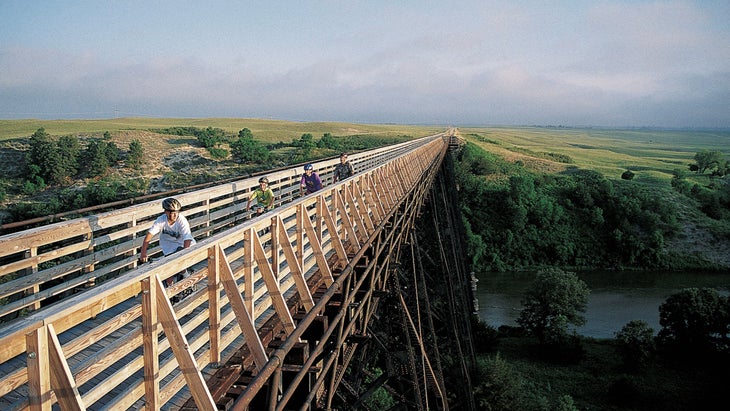
Car-free and flat as a pancake, Nebraska’s Cowboy Trail is a dream for novice cyclists looking to safely up their daily miles and explore America’s heartland. Once it’s officially completed, the bike path will be one of the world’s longest rails-to-trails projects, spanning 321 miles across the state. For now, you can ride 195 miles of its crushed limestone from the town of Norfolk in the east to Valentine in the west. The route closely follows highways 20 and 275, with small towns every 10 to 20 miles, which makes stopping for supplies and camping a cinch. There isn’t a lot of shade along the trail, which makes fall an optimal season for comfortable riding. Looking for a day ride? The 15.7-mile stretch between Valentine and Arabia Ranch crosses the Niobrara National Scenic River via a 148-foot-tall, historic railroad bridge, and passes one of the region’s last strongholds of native prairie. Make it an out-and-back and toast your miles with an Americus IPA from Bolo Beer Co. in Valentine. —J.M.
Find the Hidden Catskills, New York
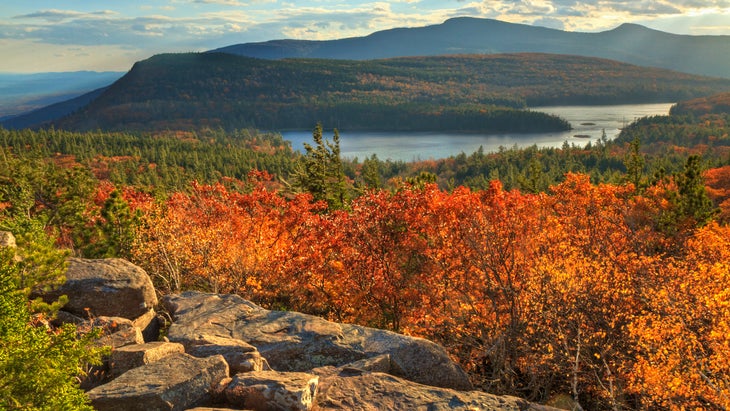
In fall, the Catskills get absolutely blanketed with New Yorkers in search of brightly-colored foliage. For good reason: this region is an idyllic weekend escape, with apple picking at quaint orchards, excellent meals at farm-to-table restaurants, and hiking underneath a kaleidoscopic tree canopy. Avoid the overcrowded Hudson Valley and head to the triangle between the hamlets of Livingston Manor, Callicoon, and Narrowsburg, which abut the Upper Delaware River. This region, once full of summer camps on tree-lined lakes, has been transformed in recent years into a new, chicer version of the Catskills of yore, thanks to Foster Supply Hospitality, run by the husband-and-wife team of Sims and Kirsten Harlow Foster. The pair’s properties includes Kenoza Hall (from $449), a 22-room lodge on Kenoza Lake; 9 River Road (from $219), a farmhouse-style inn on the banks of the Delaware River; and Hotel Darby (from $214), a mid-century modern property with a motel vibe just across the Delaware River from Narrowsburg. But it’s The DeBruce (from $525), a 14-room former hunting and fishing lodge outside of Livingston Manor, that’s the crowning centerpiece of the company. The building, which has hosted guests on and off since the 1880’s, is set in the Willowemoc Valley, just upstream from the town of Roscoe, the fly-fishing capital of the U.S. Foster Supply is developing 30 miles of trails on the The Debruce’s 600 acres, and guests have a private half-mile section of river for trout fishing. At day’s end, you can sit down to the lodge’s award-winning Saturday-night tasting menu, a multi-course feast with items sourced exclusively from New York (most from less than 20 miles away). Or relax in the Conservatory in front of the lodge’s original fieldstone fireplace, which gives off, in addition to some warming heat, that aristocratic rustic vibe that made the Catskills so popular in the first place. —R.K.
Cruise Alaska by Small Ship
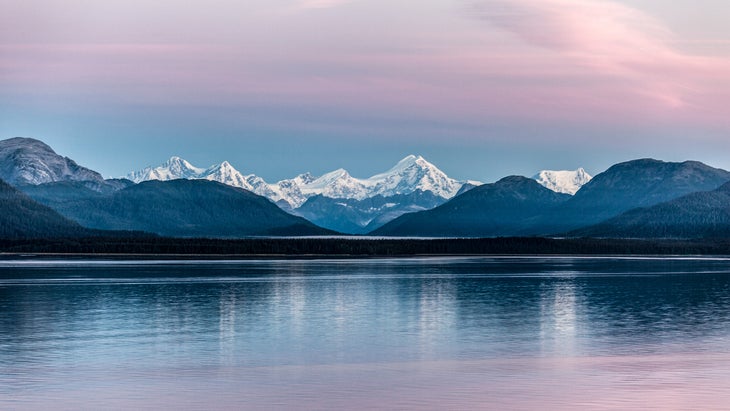
Alaska may not be top of mind when it comes to fall trips, but there are few better times in the Last Frontier to see brown bears stuffing themselves for winter, humpback whales migrating for winter, and the Northern Lights all at the same time. The best way to do all this, plus see glaciers up close, is a small ship cruise. Among the cruise companies still operating small expeditions this fall are Alaskan-owned Alaska Dream Cruises, with seven-night trips through the Inside Passage (from $5,195), plus an October trip along the same route aboard the smallest ship in the fleet, the 12-person Kruzof Explorer (from $5,195). Lindblad Expeditions (from $7,200) and Uncruise (from $4,895), which tend to target a younger demographic, offer similar Inside Passage itineraries in September. For something yachtier, charter Alaskan Luxury Cruise’s 78-foot Sea Mist, with just three cabins, for custom five to ten-night September itineraries in the southeast that take in iconic spots like Tenakee Hot Springs and the Hidden Falls Hatchery, a famous viewing spot for bears (from $59,400 for seven days and six nights, for six people). “You’re going to see something like 30 brown bears all in one spot,” says Alaskan Luxury Cruise captain Jeff Gorton. “There are going to be a million humpbacks in September, too. They’re migrated by then, and they’re just everywhere.” The weather may be colder than summer, and you’ll need some extra layering, but the wildlife viewing may never be hotter. —T.W.
Surf São Miguel, Azores
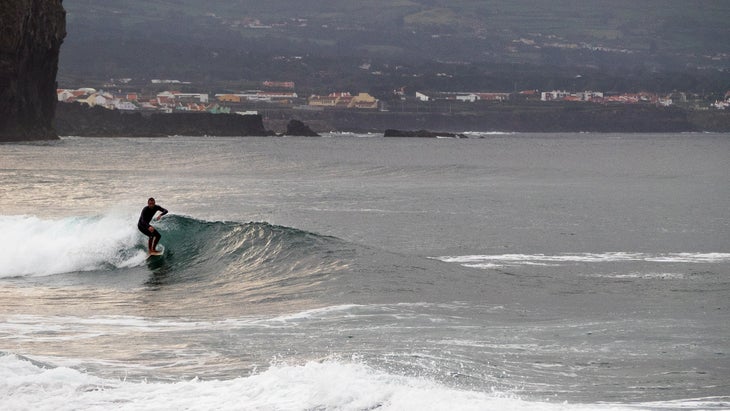
One of Europe’s best surf destinations for year-round waves is less than a five-hour flight from the U.S. East Coast. It’s called São Miguel, and fall is one of the best times to catch reliable swells in the still warm Atlantic Ocean. São Miguel is the largest of nine islands within the autonomous Azores archipelago, over 800 miles off the coast of mainland Portugal, and exposed to all of the Atlantic’s power. This is the land of long point breaks and world-class reef breaks, with sites like Ponta dos Mosteiros and Ribeira Grande getting hit with a wide range of reliable waves, from beginner-friendly swells to filthy overhead barrels. Consistent north swells usher in peak surf season from October to March, but there’s usually something breaking year-round. With more cows than people on São Miguel (population roughly 140,000), the lineups are never crowded. A 3/2 wetsuit is all you’ll need to paddle out. Azores Airlines has regular flights from Boston to the city of Ponta Delgada, on São Miguel. (As of now, there’s a mandatory COVID test administered upon entering, with a 24-hour quarantine period until the results are returned.) Stay within a short drive of the best surf spots along the northern coast at Santa Barbara Eco Beach Resort (from $305), the first ecologically-friendly ocean-side hotel to open in the Azores. The property has villas atop a bluff overlooking the beach. —T.W.
Paddle the Edisto River in South Carolina
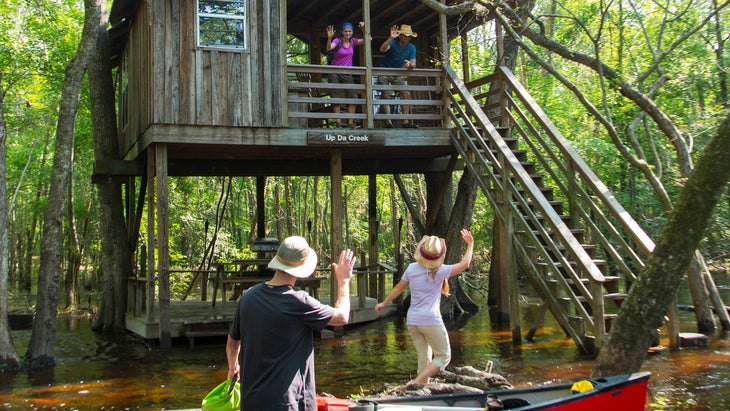
In summer, North America’s longest free-flowing blackwater river, the Edisto, can feel more like a lazy river. But in fall, the water is typically a few feet higher and faster. Plus, paddling is more enjoyable when you aren’t slapping away bugs and sweating from humidity. There are three rustic treehouses in the middle of the 48-acre Edisto River Refuge, which allow for an overnight paddle worthy of Tom Sawyer and Huck Finn. Chris Burbulak, owner of Carolina Heritage Outfitters, supplies two-person canoes and runs a shuttle up river, making the trip manageable, even for beginners. The 13-mile paddle to Burbulak’s treehouses (from $70) takes four to five hours, and guests must pack in drinking water and food. But there are plenty of large-mouth bass and catfish along the way for anglers. The fall colors are another distraction, as are sightings of the occasional Peregrine falcon, wood stork, and great blue heron. At the refuge, guests can wander trails and fry up their day’s catch (each cabin has a propane grill). After a good night’s sleep, you’ll be ready to tackle another 10 miles of paddling back to civilization. —J.M.
Swim With Whale Sharks in La Paz, Mexico
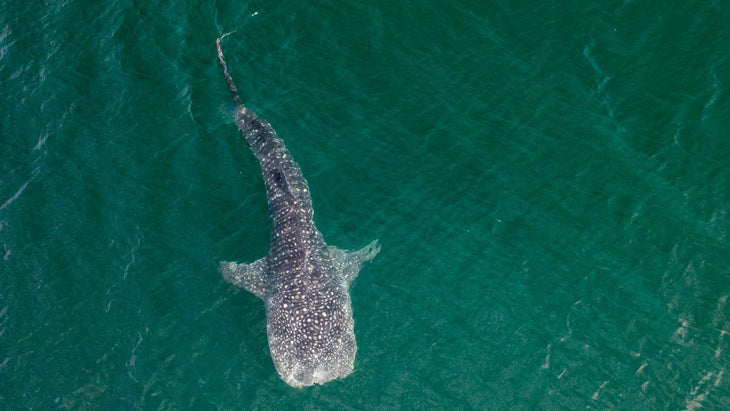
October marks the start of whale shark season in the Sea of Cortez, and the Bay of La Paz is one of the top spots in the world to swim responsibly alongside these gentle giants. The Mexican government caps the number of boats that can enter the creatures’ feeding zone—located 20 minutes off La Paz’s shore—to 20 at a time, and outfitters face a hefty fine if more than six snorkelers are near a whale shark. Book a trip with InCabo Travel, a local company that has guides with degrees in marine biology. Mexico’s hippest hotelier, Grupo Habitas, recently opened the 32-room Baja Club (from $250) along the city of La Paz’s iconic coastal boardwalk, the Malecón, giving travelers a perfect reason to spend a night or two away from resort-saturated Cabo. Use the hotel as a base camp to visit the seal colony of Los Islotes island, the uninhabited beaches of Espíritu Santo, and the Caribbean-blue waters of Balandra Bay by day. At night, feast on gourmet tacos at the new nearby restaurant Origen, then sip mezcal-spiked Baja mules on Baja Club’s rooftop bar. It may be fall, but it’ll feel like you’re living an endless summer. —J.M.
Adventure on Greece’s Largest Island
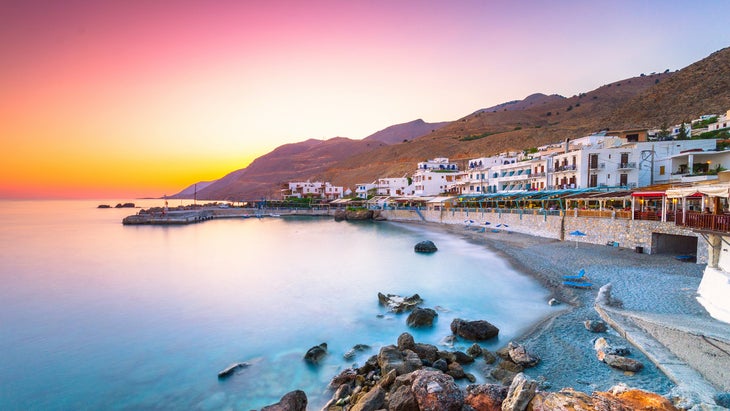
One of the first European countries to reopen its borders to tourists, Greece has been at the top of vaxi-cation lists and has a high overall vaccination rate. Food, friendliness, history, adventure, culture—Greece still has it all. If you go, skip tourist hotspots like Santorini and Mykonos—the latter was cited recently for spiking COVID-19 rates—and spend a week (or more) exploring Crete, Greece’s largest island, which has regular flights from London, Berlin, Paris, and Athens. Roughly 200 miles south of Athens, Crete has constant strong winds for windsurfing and kiteboarding, rugged mountains for trekking, and historic ruins like the Palace of Knossos, where you can geek out on the island’s ancient civilization. Because Crete straddles the Mediterranean-North African climate line, the water remains bathtub warm through early fall. You’ll want a rental car to get around the island. Kapsaliana Village, a 17-room hotel (from $217) built in the middle of the island’s largest olive grove, in western Crete, is 25 minutes from the charming town of Rethymno, and less than an hour’s drive to stunning hikes like Platania Gorge and Patsos Gorge. Even if you just walk around the island’s villages, you can’t go wrong. Be warned: the end of October and first days of November are when locals start producing their potent firewater known as raki, made from twice-distilled grapes and anise. Cretans are known for their hospitality—which can border on delightfully smothering—and it’s considered bad manners to turn down a shot of the local hooch. —J.M.
Hike Utah’s Water Canyon

Zion National Park is just 232 square miles and can get 676,000 visitors in peak summer months. Thankfully the trails throughout Greater Zion—a term coined in 2019 to encourage travelers to think beyond the relatively small park boundaries—are equally spectacular. Fall is the ideal time for hiking in the area, too: there’s no need to worry about spring run-off or triple-digit temperatures. Plus, the area’s distinctive red rocks become even more striking when set against autumn foliage, with trees lit up in vermilion, burgundy, and honey-colored hues. Tucked away on the backside of the park, Water Canyon has undulating, streaked walls and waterfalls reminiscent of the most popular canyons in Zion. The trail—6.7-miles out-and-back—gets narrower and steeper as you ascend to the canyon rim. At the top, you’ll find yourself surrounded by a sea of hoodoos (pinnacled rock formations) and gazing out at the park’s highest formations in the distance. If the thought of setting up camp after a half-day hike is daunting, there are a handful of new glamping retreats nearby, like Under Canvas (from $359) and Zion Wildflower Resort (from $379), that make cushy base camps. —J.M.
Discover Florida’s Coastal Dune Lakes
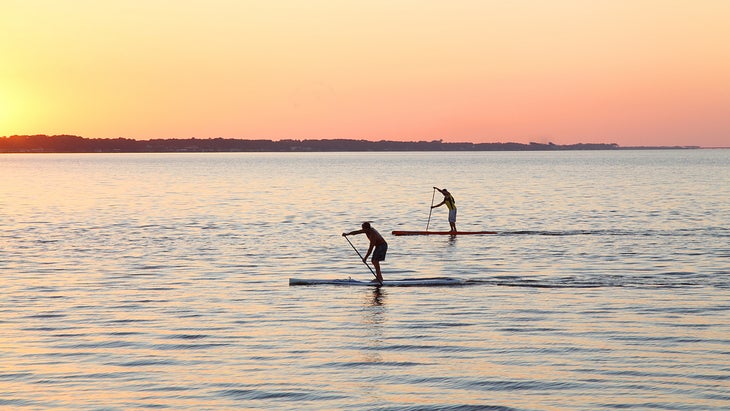
Most of the spring break activity is centered around Pensacola and the beaches to the East, leaving South Walton, a stretch of supremely scenic beaches (16 in total) largely free of the chaos—especially in fall. Here, some 40 percent of the land is preserved, and there are over 200 miles of hiking and biking trails to explore. Gulf of Mexico adventures range from paddleboarding and snorkeling—there are some 700 near-shore structures sunk along an extensive artificial reef system—to venturing inland to explore South Walton’s system of 15 coastal dune lakes, rare formations created when windblown-sand is redistributed to create shallow freshwater pools. These natural phenomenon are found only here and a handful of other places on the planet, among them Madagascar and New Zealand. The biologically-diverse, brackish ecosystems are idyllic for birdwatching, kayaking, and fishing—a secret discovery zone set just off from the beaches. The 100-acre Western Lake at Grayton Beach State Park, along scenic Highway 30A, has kayaks for rent at the onsite ranger station. Just a 15-minute drive west is Distillery 98, where you can sip sustainably-produced vodka made from 100-percent Florida Panhandle corn that gets filtered through a unique oyster shell apparatus to smooth the liquor out. Stay at the Hotel Effie (from $322) in Sandestin, which opened in February, and has a celebrity chef-led restaurant with a mean biscuits and gravy. There’s also a huge range of gulf-front vacation rentals from which you can sip your morning coffee in utter solitude. Fall visitors to South Walton often land another treat, too, as swarms of Monarch butterflies alight in parks and beachside neighborhoods starting in late September. It’s a fleeting rest stop, just long enough so the charismatic insects can refuel on their epic journey to Mexico. —T.W.
Camp on Lake McConaughy’s Shores in Nebraska
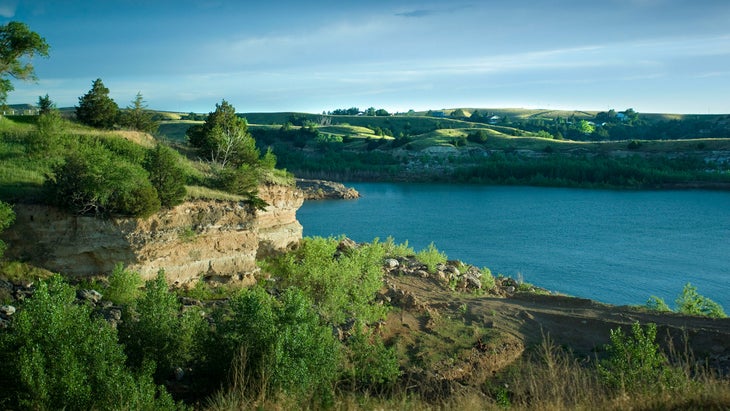
Smack dab in the middle of the Great Plains you can eek out a few more months of your summer water-sports obsessions—kiteboarding, wakesurfing, and paddle boarding—on Lake McConaughy. About a 3.5-hour drive from Denver, Nebraska’s largest lake boasts 55 square miles of astonishingly crystal blue water and over 70 miles of white sandy shoreline. As of April, beach camping is no longer first-come, first-serve during peak summer season, which had meant that scoring a site was virtually impossible. After September 12, when the crowds disappear, you can have your pick of right-on-the-sand sites—a rarity. Little Thunder and Lone Eagle campgrounds, located on the northeast shore, have some of the most coveted spots. The best kiting is on the north shore as well, but note, this isn’t a spot for beginners; experienced kiters must bring their own gear, and you’ll want a wetsuit by October. If you don’t have your own set up, Ski Patrol rents everything you need, from wakesurf boats to fishing boats—in fall, its prime season for white bass and walleye, which grilled over a fire may be the best freshwater fish you ever eat. —J.M.
Go Birding in Southern Oregon
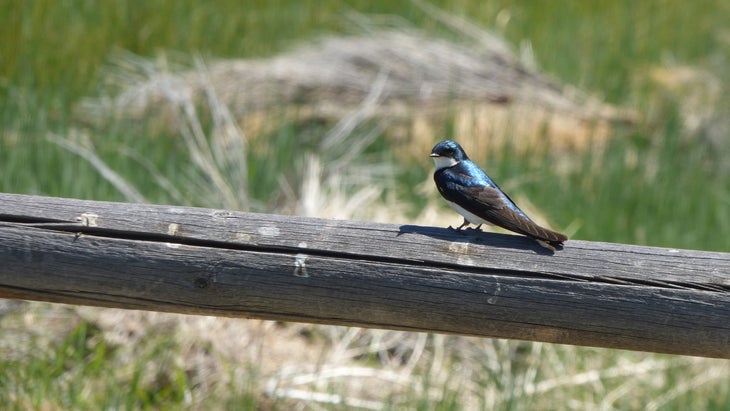
The Warner Wetlands are the perfect argument for the Oregon you never knew existed. Here, in the south central part of the state—about five miles northeast of Plush (population 46)—the old-growth firs, snowy volcanoes, and craggy coasts have given way to a prehistoric land of crescent-shaped sand dunes, sun-seared desert, and a 40-mile-long chain of twinkling lakes that attract gaggles of migrating birds every fall. The best way to explore these relics of the last ice age is by boat. During wetter years you can launch a canoe and glide along the entire 10-mile Warner Valley Canoe Trail, a route that links Turpin Lake in the north with Campbell Lake in the south with views into the grassy steppes of the Hart National Wildlife Antelope Refuge to the southeast. Bring your binoculars and be on the lookout for tundra swans, American coots, and Caspian terns. Even during drought years you can still find places to paddle. The folks at Tall Town Bike and Camp in Lakeview, about 40 miles southwest of the wetlands, rent kayaks and can give you suggestions on where to go based on water levels. If coming in from the north be sure to stop in Silver Lake at the Cowboy Dinner Tree for a 40-ounce steak. —Tim Neville
Road Bike in Tucson, Arizona
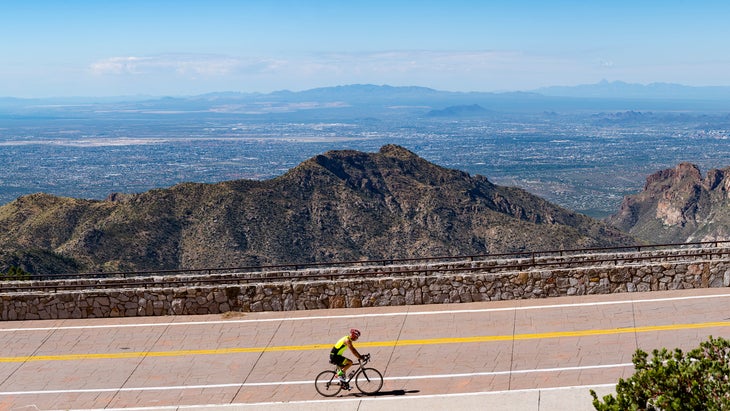
There are few better places in the U.S. for world-class cycling than Tucson—at least outside the triple-digit heat of summer. The city of 500,000 has become a magnet for serious bikers in winter, but fall may be the best time of all, with afternoon highs in the 80s (and mornings much cooler than that). The aspen and maple trees in the canyons of Santa Catalina Mountains turn bright gold and deep red, and locals come out of their summer hibernation to host a series of fall events, which includes gem shows and artisan markets that are huge draws for the artists that have put Tucson on the map. For cyclists, however, the focus is blacktop, and the sheer number of road options is the real attraction. There are easy rides, like various sections of the Loop—a 131-mile network that connects all corners of the city to one another with butter-like pavement—to classic epics like Madera Canyon, a 61 to 80 mile out and back that’s popular with the pros who train here in winter. In fall, one of the best rides may be the city’s most famous—Mount Lemmon, a nearly 7,000-foot climb over 59 miles that will take in the aspen trees in the Catalina Mountains. Back in town, there a number of new restaurants to try, including Barrio Charro, a joint project between chef Carlotta Flores of the Charro restaurant family and Don Guerra of Barrio Bread, with menu items like Southwest-inspired “tortamanos” sandwiches, with pulled pork and prickly pear BBQ sauce on house-baked azteca bread. Opening in mid-September, The Citizen Hotel (from $200) is a 10-room inn in a converted downtown building that once housed Tucson’s oldest newspaper. The property is a joint project between hotelier Moniqua Lane and Arizona winemakers Sarah and Rob Hammelman, and it will feature a 5,000-square-foot wine barreling and tasting room in the basement, an easy way to wind down after a ride. —R.K.
Weekend on Long Island’s North Fork
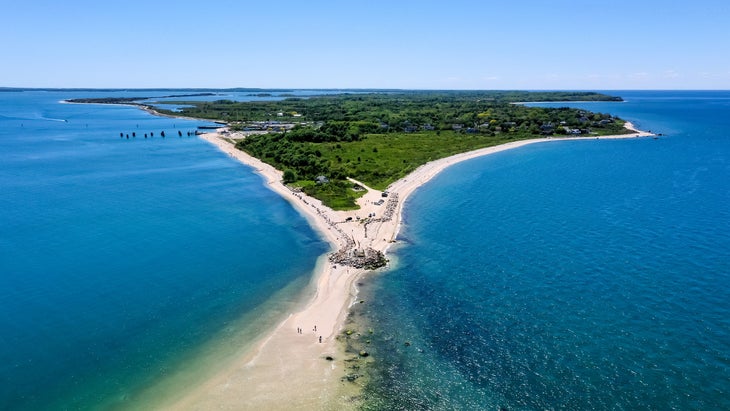
The eastern end of Long Island is no secret. In the summer, the Hamptons are awash in New Yorkers eager to see and be seen. For the most part, however, the North Fork has managed to avoid the hoopla and remain the sedate, bucolic destination it has been for the last 50 years. This is especially true in fall, when you can finally get a seat at one of the shuck-your-own oyster stands and the sugar maple and red oak trees are ablaze in color. Offset by water views at almost every turn, it’s hard to find a better place for a long weekend. Plus, the water temperature in September and October is as warm as in June, on average. Orient Beach State Park, a 363-acre spit of land jutting out into Gardiner’s Bay, is one of the few North Fork beaches that doesn’t require a residential parking permit. In the fall, walk along its empty shores or rent a bike for touring along the area’s roadways. This season is also the time of year when migrating stripers and false albacore—albies to fishing diehards—cruise through the area, chasing massive schools of sardines. There’s nothing relaxing about fly-fishing for these two species from a boat, but when you get on a blitz—the fisherman lingo for when stripers begin crushing sardines on the surface of the water, with seagulls crashing down on them and boats jockeying to get in position—there are few piscatory experiences that are more adrenaline inducing. Book a guide through Striper Forever, and stay at the Silver Sands Motel (from $179), a time capsule straight out of the 1950s, with wood paneling, shag carpeting, and laminated countertops—curated so perfectly that Vogue, Harper’s Bazaar, and Vanity Fair have staged fashion shoots here. For local oysters, stop at Little Creek Oyster Farm and Market, where they serve buckets of the bivalves on picnic tables in front of the Peconic River. For local wine—there are more than 50 wineries on the North Fork—it’s hard to beat the charm at Croteaux Vineyards, a rosé-only spot with a tasting barn and pebbled courtyard garden. For one of the best pies of your life, stop at the farm stand Briermere Farm, which has a daily bake list that will likely include standards like peach and cherry and also more exotic flavors like blackberry-apple and blueberry cream. —R.K.
Explore Iceland’s Southern Coast
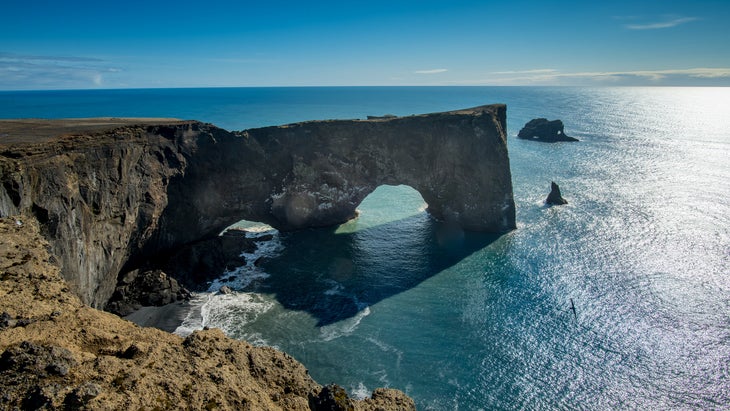
Iceland was buckling under the weight of over-tourism in recent years, but COVID changed all of that—at least for now. Tourism is on the rebound, but it’s nowhere near pre-pandemic levels, which means there’s no better time to visit. And few international adventure destinations offer the country’s current straightforward entry requirements—fully vaccinated individuals are allowed, with no testing or quarantine required, as of press time. Plus, Iceland is easy to access from the East Coast— less than a six-hour flight from New York’s JFK or Newark airports on Icelandair, which also has nonstop flights to Reykjavik from Boston, Chicago, Orlando, and Washington, D.C. One item drawing tourists back is the eruption of Fagradalsfjall, the first volcano to blow its top on the Reykjanes Peninsula in some 800 years. Fagradalsfjall is still flowing with lava for the time being. Meanwhile, rather than attempting to circumnavigate the country’s entire Ring Road, focus on just the southern coast, especially in fall, when the north coast road’s weather is unpredictable. Here’s your itinerary: hit Fagradalsfjall on arrival (it’s just 30 minutes from the airport) before or after spending the night in Reykjavik. Hotel Odinsve (from $193) is centrally located and has roomy apartments above a great wine and tapas bar called Bodega. Also, don’t miss the city’s new Sky Lagoon, with its swim-up Champagne bar and fjord-view sauna and natural hot springs. Next, head east a few hours to the log cabin-style Hotel Ranga (from $528), where hot tubs front one of the country’s best salmon-fishing rivers. If you’re feeling especially adventurous, you can day trip in a rented 4×4 or ATV into the spectacular Þórsmörk Valley, then scuba dive with Arctic Adventures in Silfra, a glacier-fed fissure with some of the best underwater visibility in the world. Not keen on cold water? Cruise east along the storied south coast and stop in the scenic village of Vik at the new Smidjan Brugghus, one of Iceland’s more celebrated craft breweries. In autumn, you might even get to see the Northern Lights, which become visible in the skies from late August onwards. —T.W.
Hike and Bike Northern New Mexico
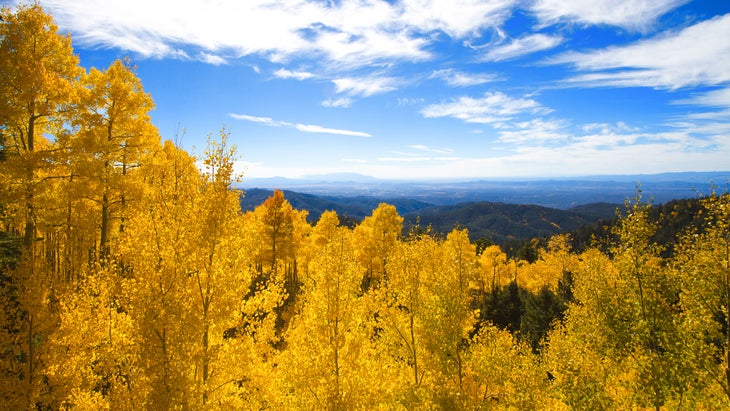
When the aspen trees in New Mexico’s Sangre de Cristo Mountains go into bright yellow overdrive in fall, there are few more dramatic destinations in the U.S. than Taos. So leaf peeping? Check. Native culture and excellent dining options? Check and check. And, oh yeah: Taos is an absolute world-class outdoor destination, too. Hiking and mountain-biking on the renowned South Boundary Trail, fishing for wild rainbows in the Rio Grande del Norte National Monument, and summiting 13,159-foot Wheeler Peak, the state’s highest—these are all standard and beloved adventure options. There are lesser-known gems, too, like mountain biking the relatively easy, if wildly remote, Valle Vidal Loop, roughly 47 miles of old two-track roads that go into the heart of the mountain basin. Fall brings chillier air to this part of north central New Mexico, but it’s still comfortable, temperature-wise, to camp out in the 1.5 million-acres Carson National Forest. In town, there are a few new and noteworthy restaurants, including Aly’s Food Truck, where Kiwi Alyson Hyder churns out New Zealand-style meat pies and puff pastry sausage rolls. At the Bavarian-inspired Der Garten, a food truck stationed near Taos Ski Valley, the bison on the menu is sourced from the Taos Pueblo, the Native community a mile north of town that has been in existence for over 1,000 years. For lodging, check out Hotel Luna Mystica (from $90), where you can crash in one of 20 vintage camper trailers—from a 1960s Airstream to a 1967 Avian Tourist—all immaculately restored. Each trailer is equipped with kitchen facilities and its own deck looking over the vast Taos Mesa, just eight miles from town. At night, while taking in the stars overhead, it’ll feel a million miles from just about anything. —T.W.
Multi-Sport in Puerto Rico
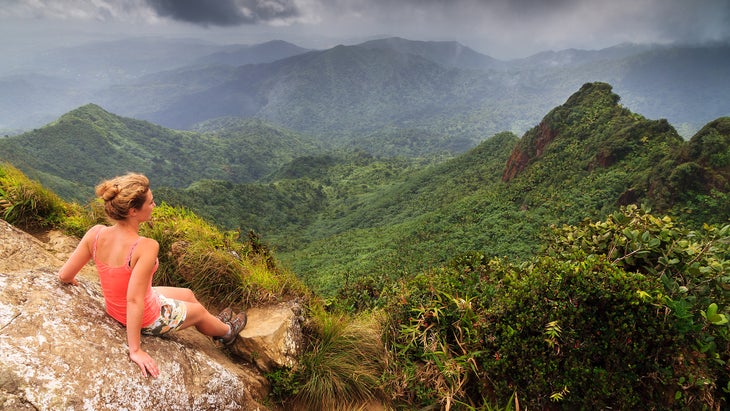
The beauty of Puerto Rico, besides the island’s generally chill vibe, is that you can make a long weekend here as urban or outdoorsy as you want. It was hit with back-to-back hurricanes a few years ago and recovery has been slow, but the island is firmly on the upswing. New hotels are opening, and the outdoor activities that made the island a beacon for adventurers are still here: waves for surfers, singletrack rides that unspool from jungle to beach (like the Domes Rincon Mtb Trail), and the bioluminescent bay off nearby Vieques island that’s considered the brightest in the world. For lodging in Old San Juan, Palacio Provincial (from $189) is new on the scene, with 43 rooms and a rooftop pool, or for a splurge check out the oceanfront rooms at Dorado Beach, a Ritz-Carlton Reserve (from $1,349). Surfers know that Isla del Encanto’s waves start to whip into shape from September onward—it’s still hurricane season, after all. For breaks with fewer crowds, paddle out at north coast spots like Playa Jobos and Isabela. There’s also hiking within the only rainforest in the U.S., El Yunque National Forest, where the 2.3-mile Toro Wilderness Trail leads to the park’s highest peak, at 3,524 feet. Or venture deeper inland to the Cordillera Central mountain range for cave tubing and cliff jumping along the Tanamá River, where pre-Colombian petroglyphs and karst landscapes show off a side of Puerto Rico that few visitors know exist. —T.W.
Glamp in Maine
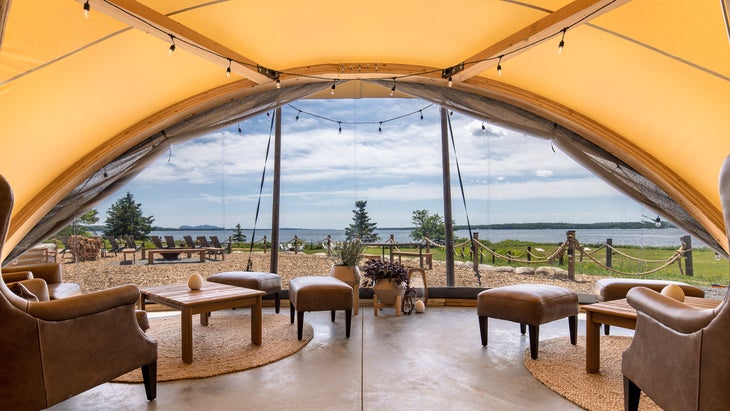
Maine’s Acadia National Park, encompassing the most impressive (and highest) rocky headlands along the entire U.S. East Coast, gets the briefest reprieve from its summertime rush before the autumn masses arrive. This sweet spot happens in September, just before the deciduous trees start flaming all-out crimson. This year, during its first season in Maine, the glamping outpost Under Canvas Acadia is staying open until October 11 (from $399). The camp’s 63 safari-inspired tents—all with private bathrooms and some with private fire pits—hug a rugged stretch of coastline along the Blue Hill Peninsula, less than 20 miles northwest of the park, with views of Cadillac and Dorr mountains shimmering across the bay. The night skies here are extra inky, and to take advantage of them Under Canvas offers “Stargazer” tents with plexiglass windows in the ceiling. The camp’s dinner is served at a big communal tent near the shoreline, with the fruits of the local seas—clams, steamers, mussels, and lobster—figuring heavily among the offerings. From the property, it’s an easy to drive to the park, where you can spend your days hiking or biking Acadia’s roughly 120 miles of trails. There’s also bioluminescent kayaking in historic Castine, and hopscotching between lighthouses and lobstering villages by car along the greater Blue Hill Peninsula. If you do the latter, make sure to check out the three-barrel microbrewery at Deep Water Brewing Co., which has excellent craft ales on tap and a selection of local oysters. Of course, no one would blame you if you simply relax in your tent. —T.W.
Chase Volcanoes in Lake Atitlán, Guatemala
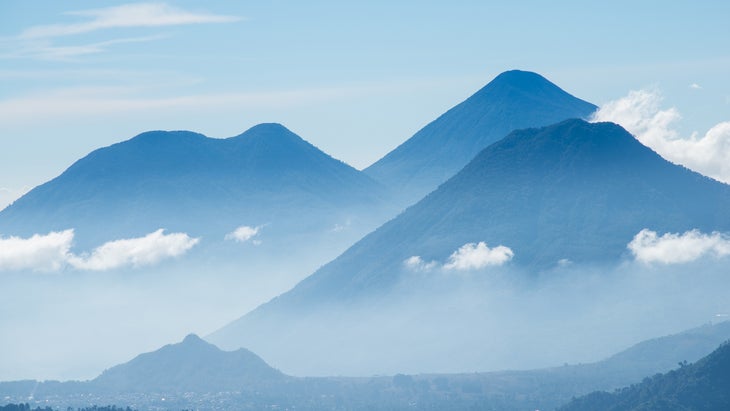
Lake Atitlán is Central America at peak seduction, with jaw-dropping volcano views, deep blue water, and Mayan culture at every turn. It’s three hours from Guatemala City’s La Aurora International Airport, but it feels a thousand years away. While autumn is technically still the rainy season in this part of the world, the showers never last long, you can experience the country’s rural highlands at their least trafficked, and hotel rates are lower, too. There are plenty of rustic places to stay along and around the lakeshore, but you won’t regret a splurge on Casa Palopó (from $197), where rooms and villas are decorated with indigenous Guatemalan artwork and overlook the caldera-turned-lake. From the property, birdwatch in the surrounding Sierra Madre highlands and spot endemic species like the pink-headed warbler and azure-rumped tanager. There’s excellent hiking around Lake Atitlán, too, including a strenuous four-mile jaunt to the summit of Volcán San Pedro, at 9,908 feet. Spend one night in the old-world city of Antigua at Villa Bokéh (from $197), a colonial-style villa set amidst the jungle. The hotel has just seven rooms decorated with the owner’s art collection, fire pits in a lush garden, and volcano views all around. —T.W.
Surf California’s Quieter Coast
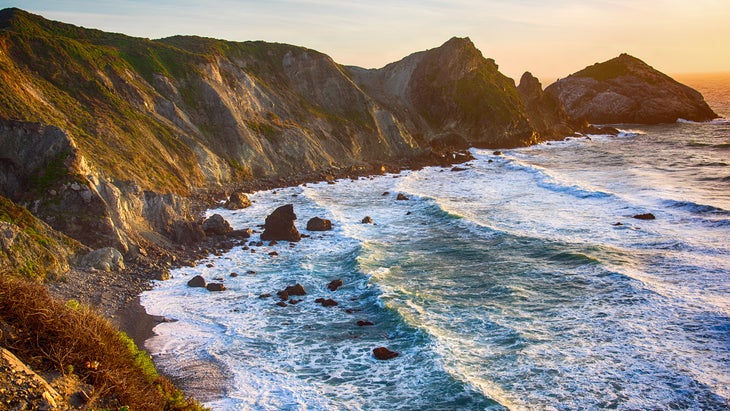
Located roughly halfway between Los Angeles and San Francisco, San Luis Obispo County unspools for more than 80 miles along California’s Central Coast, striking a mellow note compared to the crowded vineyards of Napa Valley and packed surf breaks of SoCal. September ushers in SLO’s best surf season, thanks to favorable offshore winds and regular north and northwest swells that see breaks like the relatively mellow Cayucos Pier barreling with regularity. (Cayucos is worth a stop even if you don’t surf: you can learn how to make a meal out of marine algae during seaweed foraging tours at Marley Family Seaweeds.) The same is true of the Rock, in Morro Bay, where you surf in the shadow of a preserve for endangered peregrine falcons. For the best autumn road trip through the region, start with some harvest-season wine tasting in the vineyards of the Edna Valley, just outside SLO, then head north to the oceanside enclaves of Cambria and San Simeon. In Cambria, the newly opened White Water lodge (from $224) on Moonstone Beach has hygge-inspired interiors with vast coastal views and complimentary bikes from cycling brand Linus that you can use to tool around. September and October are also the best months to see large populations of elephant seals hauling their enormous bodies onto the beaches at Piedra Blancas Light Station. Avoid the crowds of onlookers by leaving the parking lot for the four-mile round trip hike past secluded coves along the Boucher Trail to see smaller gatherings of the 5,000-pound pinnipeds. —T.W.
Credit: Source link

















